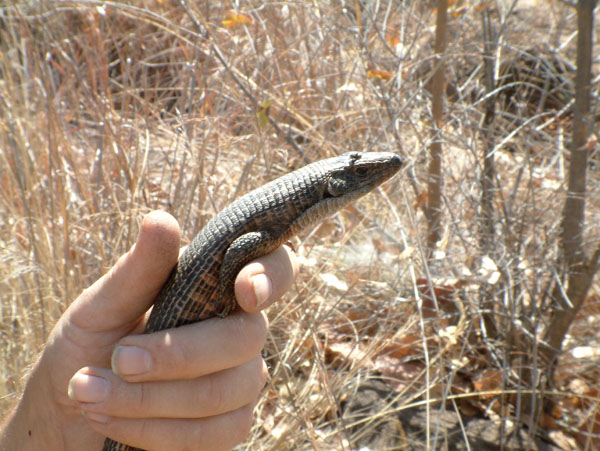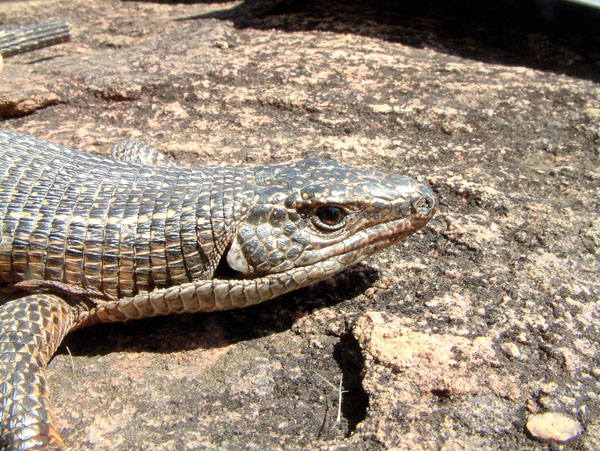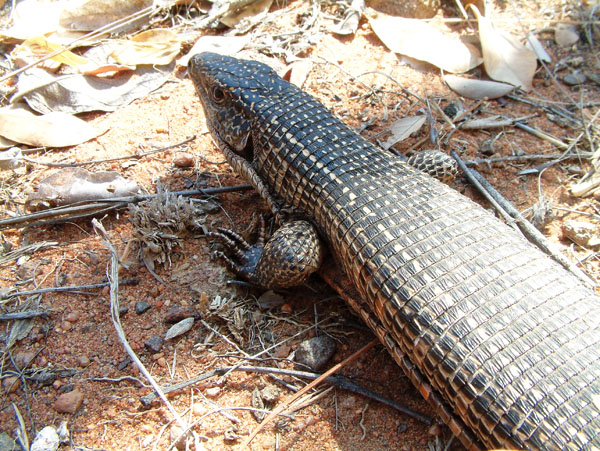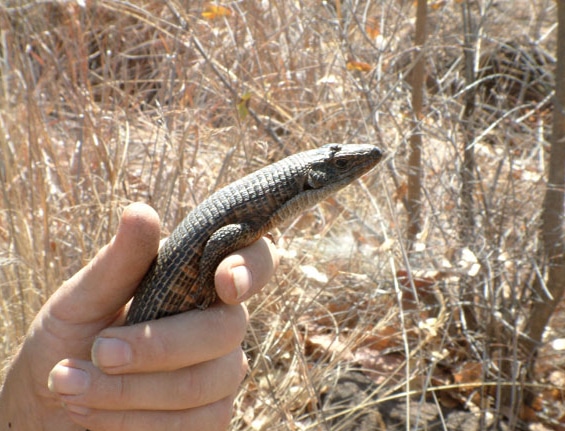The plated lizard is a challenging lizard to keep.
I am sure that most of us, if we dust the cobwebs from our memories, can remember the first snake or lizard we bought that sparked our interest in reptile keeping. Although it only seems like yesterday, I have to go back some 30-plus years to remember mine. I purchased a pair of giant plated lizards (Gerrhosaurus validus), which I acquired for a relatively large sum of money (at the time), from a local pet shop. Even though I worked in zoological collections for the following 20 years, it was not until I spent six month in South Africa that I had the chance to reacquaint myself with this lizard once again.
Read More by Paul Donovan
Motorbiking to Botswana's Reptiles

Paul Donovan
The individual illustrated here was captured in the northern part of South Africa a few kilometers from the border to Botswana.
Walking through the bush one incredibly hot afternoon, I heard a rustling sound near a pile of rocks. Now, being someone who has to investigate such noises (the last time I did that I caught a 4-foot-banded snouted cobra!), I eventually spooked this large black lizard out of hiding, only to watch it dart beneath another huge boulder. After much grunting and groaning, and almost dropping the boulder on my leg as the lizard shot out, I did eventually manage to catch it.
Unfortunately, as I grabbed it, it shed its tail, but nonetheless, it was a fine male specimen of good size. And, just as I remember with the pair I’d kept all those years ago, it wriggled like a magician trying to escape from a straightjacket, and proceeded to spray me with the foul contents of its cloaca. Nice to make your acquaintance again!
All in the Family
The family Gerrhosauridae encompasses six known genera. Four of these occur in sub-Saharan Africa and make up the subfamily Gerrhosaurinae: Angolosaurus skoogi, Cordylosaurus subtessellatus, Gerrhosaurus (of which there are six species: Gerrhosaurus flavigularis, G. major, G. multilineatus, G. nigrolineatus, G. typicus and G. validus) and Tetradactylus (of which there are six species: Tetradactylus africanus, T. breyeri, T. eastwoodi, T. ellenbergeri, T. seps and T. tetradactylus). Two further genera, Tracheloptychus and Zonosaurus, are restricted solely to Madagascar, and they make up the subfamily Zonosaurinae. They include: Tracheloptychus madagascariensis, T. petersi, Zonosaurus aeneus, Z. anelanelang, Z. bemaraha, Z. boettgeri, Z. brygooi, Z. flavescens, Z. haraldmeieri, Z. karsteni, Z. laticaudatus, Z. madagascariensis, Z. maramaintso, Z. maximus, Z. ornatus, Z. quadrilineatus, Z. rufipes, Z. subunicolor, Z. Trilineatus and Z. tsingy.

Paul Donovan
Gerrhosaurus validus is a terrestrial lizard that seldom ventures far from a pile of rocks or clump of thorny bushes.
Trace their ancestry back, and it appears that the family almost certainly evolved as one before Madagascar split from the African continent during the Cretaceous period, 145 to 65 million years ago. This is how the two Madagascan genera then evolved independently.
Because of their similarity in appearance, Gerrhosauridae was initially classified as a subfamily of Cordylidae, but a taxonomic review elevated it to full species status.
Of Gerrhosaurus validus, two subspecies are recognized. The first is the nominate race G. v. validus (the species illustrating this article). This species can be distinguished by the presence of 14 to 16 ventral scale rows, and 18 to 24 lamellae on the fourth toe. The dorsal scales number 28 to 44 longitudinal rows, with 52 to 55 transverse rows. The femoral pores number 18 to 25 in both sexes. The subocular scale (a scale beneath the eye) does not make contact with the lip. Its range is quite broad, extending from Maputaland through to Zambia.
The second subspecies is G. v. maltzahni. It differs in having 12 to 14 ventral scale rows, 15 to 17 lamellae on the fourth toe and the subocular scale borders the lip. Its range extends from central Namibia, pushing just into southern Angola. Both races have pronounced femoral glands and conspicuous pores.
As lizards go, G. validus is quite an easy species to identify, as it has a rather distinctive coloration and is of a good size. Snout to vent length is 93⁄4 to 113⁄4 inches, with the tail being almost as long. Females are slightly smaller than males, not only in length but also body girth, and they are not quite as stocky.
Adults are dark brown to sooty black, with the dorsal scales having small yellow spots, which give the body a speckled appearance. The dorsal scales have a rectangular shape to them and slightly overlap one another like the tiles of a roof. These scales have underlying osteodermal plates that afford the lizard tough armor plating. One of the most identifiable features of this lizard, though, is the presence of a pair of thin dorsolateral stripes extending down either side of the back like railways lines. The throat is a dirty, creamy-white color.
Juveniles are similarly colored to adults, being black with the exception of having much more yellow in the form of characteristic yellow spots on the back and bars on the flanks. These gradually fade as the lizards mature, and they can be completely absent within about a year.
The head has a rather narrow, triangular shape to it, with a rounded snout, and as with the body, the head is protected by large osteodermal scales. The tympanic membrane (ear) is large, as is the tympanic shield, the latter having a triangular shape to it. The prefrontal scales touch, and the frontonasals make contact with the single large rostral scale (the scale at the front of the snout).
The tail, which may be almost as long as the body, is covered in a carpet of narrow, pointed scales. These are rear facing, and as they are slightly raised, they overlap one another and give the tail the appearance of a spiky branch. The tail not only serves as a defense when the lizard jams itself into a crevice, but can be swung from side to side to deliver painful blows. Unlike many lizards, I have noticed that plated lizards do not seem as willing to shed their tails quite as quickly as other species do. (OK, the individual I captured did, but others I have come across seemed reluctant to do so.) This may be because they have great faith in their tough armor coating to afford protection.
Both the body and tail have a generalized flattened profile, giving the lizard the appearance of having been run over. This shape is utilized to great advantage as a defensive measure. Extremely shy by nature, the lizard skitters into the nearest crevice when threatened and inflates its body by sucking in air, thus jamming itself in tight. As the tail is the last part of the body to disappear into the crevice, it is the first part of the body the pursuer is confronted with. And as it is covered in spiky scales, it presents a formidable barrier. Only when the lizard is confident that the threat has passed does it venture back out. One of the reasons why this lizard appears to be so shy is that its size makes it a hearty meal for a hungry bird of prey.
Terrestrial Habitat
Gerrhosaurus validus is a terrestrial lizard that seldom ventures far from a pile of rocks or clump of thorny bushes. It is a warmth-loving species and tends to occur in the warmer regions of southern Africa. The individual illustrated here was captured in the northern part of South Africa, a few kilometers from the border to Botswana. Typical habitat is arid veld or dry savannah and grasslands with rocky escarpments. This is one of the reasons why giant plated lizards are so difficult to photograph, let alone catch. As soon as they suspect danger is afoot, they are gone. During my stay in South Africa at the time, I never managed, no matter how careful and quiet I was, to photograph one basking.

Paul Donovan
One of the most identifiable features of this lizard, though, is the presence of a pair of thin dorsolateral stripes, extending down either side of the back like railways lines.
Diet
Dietary requirements for this lizard are quite varied. The staple diet consists of all manner of invertebrates, from crickets and locusts to mantids and beetles. They will also take vegetable matter, such as shoots, fallen fruit and flower heads. Given the chance, and if they can catch them, they will also eat small lizards. Although few references make mention of it, newborn rodents will also be taken.
When keeping these lizards in captivity, much of their diet is easily met. I gave mine a small dish of mixed fruit and vegetables three to four times a week. I used to add four or five pinkies to this, but noticed the lizards quickly developed signs of obesity, so I reduced these to two a week. About 20 odd years ago, there was very little in the way of invertebrates to feed to captive lizards, but I used to catch cockroaches, grasshoppers and other native insects to add some variety to their staple diet of mealworms.
Heat Lovers
If you are lucky enough to manage to get your hands on one of these lizards, the first thing you will notice is that they are true warmth-loving reptiles. The individual I captured was caught during the hottest part of the day, when a ground temperature reading I took showed it to be 104 degrees Fahrenheit. In fact, the ground was so hot that every time I put my hands on it, it felt like I was touching the hotplate of an oven. I can remember the pair I had all those years ago would spend almost all their time basking beneath a heat lamp. I have also experienced this with other members of the genus, notably G. nigrolineatus. For this reason, I would provide a cool end temperature of 77 to 80 degrees, with a heat lamp suspended at the other end where the lizard has access to a much higher basking temperature of about 95 degrees. Even where the ambient temperature is raised, giant plated lizards will still bask.
As these are active lizards, they should be given a good amount of space to move around. An enclosure that measures 5 feet long, 3 feet wide and 3 feet tall would suit one well.
The floor should be covered with sand or Repti-Bark, and it should include some form of hiding area. Remember, these lizards like to squeeze into tight spaces, so a pile of rocks with suitably sized crevices will afford them good cover. Do make sure, however, that the rocks are secure and cannot be dislodged. Alternatively, you can always use one of the preformed caves available on the market. Don’t forget, the cage will also require full-spectrum UVB lighting. During the summer months, provide 12 hours on and 12 hours off. This can be reduced to a ratio of 10 hours of light and 14 hours of darkness during the winter.
Although water should always be made available in the form of a shallow water bowl, they rarely seem to drink from one, getting much of their liquid requirements from the fruit, vegetables and insects upon which they feed. These lizards come from quite dry areas where water is often scarce. That being said, I have seen them lap droplets of water from plants, so I presume they may obtain this in the form of early morning dew. For this reason, it may be worth giving the enclosure a light spraying once a day. Misting and a shallow water bowl should maintain the humidity in the 50- to 55-percent region, which is ideal.
Plated Lizard Breeding
During the breeding season, males develop a pinkish-red tinge to the throat and sides of the head. Although generally quite sociable up until now, males will squabble amongst themselves and defend a territory. Females are pursued with relentless passion until they are cornered. Following a successful mating, come mid-summer, the female searches out a crevice laden with soil and lays four (sometimes as few as two) large, creamy-white, oval-shaped eggs, each measuring 1 by 13⁄4 inches.
With captive breeding, the eggs should be removed and incubated in damp vermiculite at a temperature of 86 degrees Fahrenheit. Some 70 to 80 days later, the 53⁄4- to 61⁄2-inch hatchlings emerge. Newborns differ slightly in coloration from the adults, showing a black base color adorned with distinctive yellow spots on the back and bars on the flanks. Juveniles may remain in the protective shelter of the nest site for several days before dispersing. Care of the juveniles follows that of the adults.
Worth the Effort
As captive lizards go, G. validus can be quite an easy pet to cater to, placing few challenges on the reptile keepers’ plate. It is a good-sized lizard that will usually become accustomed to captive conditions quickly. This means yours should eventually sit out and bask and not skitter away at the first sight of a human peering through the enclosure at it. And, if you are so inclined, pet giant plated lizards will often allow themselves to be regularly handled. Mine became tame enough to accept food from my fingers. This is a lizard species that I would thoroughly recommend if you happen to come across one. I certainly have fond memories of mine.
Paul Donovan is a biologist who has worked with reptiles and insects for the past 30 years. After working in several zoological collections in the UK, he now resides in Botswana, where he has been for the past six years. Apart from lecturing widely to various government organizations, private companies and schools on snakes and snakebites, he also runs a motorbike tour company and organizes reptile holidays in Botswana. Paul can be contacted at paul.motorcycleadventures@gmail.com.



